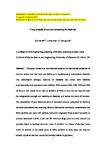Creep analysis of concrete containing rice husk ash
| dc.contributor.author | He, Z-H | |
| dc.contributor.author | Li, Long-yuan | |
| dc.contributor.author | Du, S-G | |
| dc.date.accessioned | 2017-03-27T09:55:03Z | |
| dc.date.accessioned | 2017-03-27T10:04:10Z | |
| dc.date.available | 2017-03-27T09:55:03Z | |
| dc.date.available | 2017-03-27T10:04:10Z | |
| dc.date.issued | 2017-07 | |
| dc.identifier.issn | 0958-9465 | |
| dc.identifier.issn | 1873-393X | |
| dc.identifier.uri | http://hdl.handle.net/10026.1/8694 | |
| dc.description | File replaced (incorrect version) on 18/7/22 by KT (LDS) (1.4) | |
| dc.description.abstract |
This paper presents an experimental study on the mechanical properties of concrete added with rice husk ash (RHA) as a supplementary cementitious material. The compressive strength, modulus of elasticity and creep were obtained experimentally from specimens with different RHA contents (0%, 10%, 15% and 20% of binder). The results show that the addition of RHA in concrete can improve both the compressive strength and modulus of elasticity and reduce the creep of concrete. The examination of pore micro-structure of hardened concrete using both the mercury intrusion porosimetry and scanning electron microscope techniques demonstrates that RHA particles can react with calcium hydroxide originated from cement hydration to produce additional C-S-H, which can fill voids and large pores and thus reduces the porosity related to capillary pores and voids. In addition, the release of absorbed water, which is retained in the small pores of RHA particles at early days, can improve cement hydration and thus reduce the porosity related to gel pores. | |
| dc.format.extent | 190-199 | |
| dc.language | en | |
| dc.language.iso | en | |
| dc.publisher | Elsevier BV | |
| dc.relation.replaces | http://hdl.handle.net/10026.1/8693 | |
| dc.relation.replaces | 10026.1/8693 | |
| dc.subject | Concrete | |
| dc.subject | Rice husk ash | |
| dc.subject | Compressive strength | |
| dc.subject | Elastic modulus | |
| dc.subject | Creep | |
| dc.title | Creep analysis of concrete containing rice husk ash | |
| dc.type | journal-article | |
| dc.type | Journal Article | |
| plymouth.author-url | https://www.webofscience.com/api/gateway?GWVersion=2&SrcApp=PARTNER_APP&SrcAuth=LinksAMR&KeyUT=WOS:000403123000018&DestLinkType=FullRecord&DestApp=ALL_WOS&UsrCustomerID=11bb513d99f797142bcfeffcc58ea008 | |
| plymouth.volume | 80 | |
| plymouth.publication-status | Published | |
| plymouth.journal | Cement and Concrete Composites | |
| dc.identifier.doi | 10.1016/j.cemconcomp.2017.03.014 | |
| plymouth.organisational-group | /Plymouth | |
| plymouth.organisational-group | /Plymouth/Faculty of Science and Engineering | |
| plymouth.organisational-group | /Plymouth/Faculty of Science and Engineering/School of Engineering, Computing and Mathematics | |
| plymouth.organisational-group | /Plymouth/REF 2021 Researchers by UoA | |
| plymouth.organisational-group | /Plymouth/REF 2021 Researchers by UoA/UoA12 Engineering | |
| plymouth.organisational-group | /Plymouth/Research Groups | |
| plymouth.organisational-group | /Plymouth/Research Groups/Marine Institute | |
| plymouth.organisational-group | /Plymouth/Users by role | |
| plymouth.organisational-group | /Plymouth/Users by role/Academics | |
| dcterms.dateAccepted | 2017-03-15 | |
| dc.rights.embargodate | 2018-3-19 | |
| dc.identifier.eissn | 1873-393X | |
| dc.rights.embargoperiod | Not known | |
| rioxxterms.versionofrecord | 10.1016/j.cemconcomp.2017.03.014 | |
| rioxxterms.licenseref.uri | http://www.rioxx.net/licenses/all-rights-reserved | |
| rioxxterms.licenseref.startdate | 2017-07 | |
| rioxxterms.type | Journal Article/Review |


